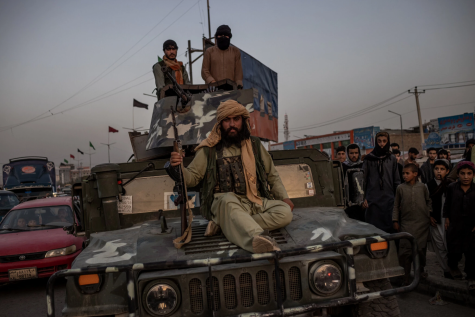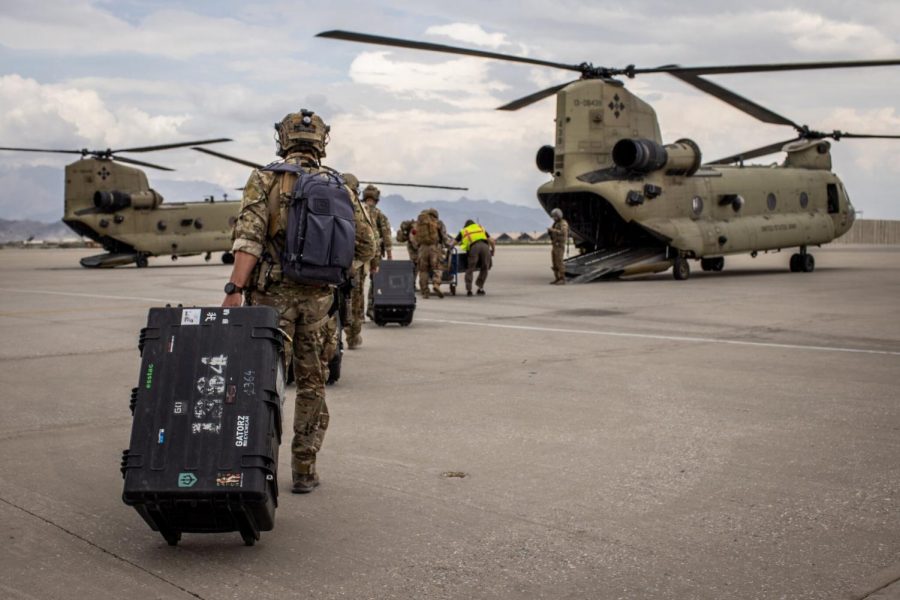Nearly a two decade war concludes in tragedy
U.S. and other coalition soldiers boarding helicopters to leave Bagram Air Field in May.
October 1, 2021
The American mission in Afghanistan has come to a gruesome and chaotic end.
The United States military departed the country on August 30, 2021, ending a 20-year residency and leaving Afghanistan in the Taliban’s hands. As the last evacuation flight departed, over 100,000 people were left behind, who held the possibility of eligibility for U.S. visas. A summertime offense delivered victory to the Taliban on August 15, 2021, hours after President, Ashraf Ghandi, fled the country, allowing Taliban leaders to take over his presidential offices, urging tens of thousands of citizens to the country’s borders. Others fled to an international airport in Kabul, where crowds scrambled to board evacuating planes. Days of chaos were far from over as the airport had a punctuated suicide attack on August 26, that killed an estimate of 180 people, including 13 American troops. Being known as one of the deadliest attacks of the war, the troops were the first American troops to die in the country during service since February 2020.
The collapse of the Afghan government, after the United States spent billions to provide support and the Afghan security forces, was a suppressed and violent coda to the United States military mission in America’s longest war. A mission that continued throughout four presidents, reckoning with American casualties, a heartless enemy, and an Afghan ally, Pakistan, which supported and supplied the Taliban with creating a safe haven for militants.
Around mid April, President, Joe Biden, declared that the United States accomplished it’s mission in denying terrorists a safe haven in Afghanistan, announcing all American troops would leave the country by the 20th anniversary of September 11, 2001, terrorist attacks that drew America into the longest war, although Biden later moved to date of withdrawal to August 31.
“That does not mean we’re turning away from Afghanistan. We are going to remain committed to the government, and remain committed diplomatically. But in terms of where we will be investing force posture, our blood and treasure, we believe that other priorities merit that investment,” declared Biden.
The United States had planned to leave behind 650 troops to secure the Kabul embassy, but a sudden Taliban victory forced the embassy into a panicked shutdown, as staff shredded and burned sensitive documents. Ultimately, Taliban gunmen went door-to-door in several Kabul neighborhoods, searching for any supporters of the American government or mission. “This did unfold more quickly than we had anticipated,” Biden mentioned in a speech on August 16, standing by his decision to end American military involvement in Afghanistan.
America’s incipient involvement in Afghanistan predates weeks after Al Qaeda attacked several monumental structures in the United States on September 11, 2001, where President George W. Bush announced American forces had launched attacks against the terrorist group and Taliban targets in Afghanistan. Bush further said the Taliban, which governed the majority of Afghanistan, had rejected his demand to turn over Al Qaeda leaders that planned the attacks from internal bases.
“These carefully targeted actions are designed to disrupt the use of Afghanistan as a terrorist base of operations, and to attack the military capability of the Taliban regime,” declared President Bush. Bush warned that Operation Enduring Freedom would entail a “lengthy campaign unlike any other we have ever seen.
By December 2001, Osama Bin Laden, leader of Al Qaeda, fled to locate safety in Pakistan, a nominal United States ally. Essentially, American forces didn’t invade, and Pakistan evolved into a safe haven for Taliban members, who subsequently crossed the border to attack American and Afghan forces. American troops were quick to depose the Taliban government and it’s forces. Corresponding in December 2001, the Taliban offered an unconditional surrender, which the United States rejected. In May 2003, Donald Rumsfield, Defense Secretary, announced an end to major combat operations in the country.
Evolvement emanated after the United States and NATO attempted to rebuild a failing state and establish a Western-style democracy, ultimately spending billions to reconstruct a poor country, ravaged by two decades of war, first the Soviet occupation and then the civil war. Although some early successes of the trying democracy included new schools, hospitals, public facilities, and women earning higher education, rampant corruption occurred with millions of dollars being stolen. In 2003, with 8,000 American troops in Afghanistan, the United States began a shift in combat resources to the war in Iraq which started in March early that year, enabling the Taliban to reassemble their fighting capabilities.
In 2009, President Barack Obama, began deploying thousands more American troops to Afghanistan as a “surge,” reaching around 100,000 by 2010, but the Taliban grew stronger and inflicted heavier security forces.
In May 2011, an American Navy SEAL team killed Osama Bin Laden in a compound in Abbottabad, Pakistan, where he had resided near a military academy. By June, Obama declared he would start bringing American troops home and relinquish security duties to Afghanistan by 2014. Following this, the Pentagon concluded the war conflicts would be over with a negotiated settlement. With the war at a stalemate, Obama decided to end major combat operations on December 31, 2014, with a transition to training and assisting Afghan forces.
Nearly three years later, President Donald Trump believed that although his first instinct was to continue removing American troops, he proceeded to prosecute the war, stressing “any troop withdrawal would be based on combat conditions, not predetermined timelines.” Trump’s administration had been communicating with the Taliban since 2018, leading to formal negotiations that excluded the Afghan government, led by Ashraf Ghandi.
Ahead of the scheduled troop withdrawal in August, the Taliban’s summer military campaign had forced widespread surrenders and retreats by Afghan government forces. Essentially, they renounced without a fight, correlating a rise of civilian casualties.
In February 2020, the Trump administration signed an agreement with the Taliban that entirely removed American troops from Afghanistan by May 1, 2021, though President Biden later extended the deadline. In return, the Taliban pledged to separate themselves with terrorist groups like Al Qaeda and Islamic State affiliation to reduce violence and further a negotiation with the allied American and Afghan government. However, the agreement failed to include a mechanism to enforce the Taliban a commitment, and the exclusion of the Afghan government would further strain it’s relations with the United States. After signing the agreement, the Taliban stopped attacking American troops and refrained from major bombings in Afghan cities, as the United States reduced air support.

Primary objectives of the negotiation included Afghan leaders and the Taliban to arrange a new government and constitution, reduce violence, and forge a lasting cease-fire. Consequently, the government accused the Taliban of assassinating Afghan government officials and security force members, civil society leaders, human right workers, journalists, and shooting women in broad daylight. Considering the battlefield position and the American troops withdrawing, the Taliban maintained the domination with the Afghan government beginning in September in Doha, Qatar, but eventually stalled. Enticing the Pentagon to declare militants violating pledges to reduce violence and ending ties with terrorist groups.
Afghan security forces struggled against the Taliban as military and police units were hollowed by desertions, low recruitment, poor morale, and a theft of equipment, suffering high casualty rates, which American commanders deemed unsustainable. “Afghanistan political leaders gave up and fled the country,” examines Biden, accusing the military of abandoning after two decades of United States training.
Taliban forces embraced capitals, government counterattacks fought to repossess bases and districts, as former Afghan officials mobilized and volunteered in private militias which were financed by the government. Unfortunately, the Taliban remained dominant over capitals before moving into Kabul, frightening the development for those who believed American allies rebuilt a life under protection. Once in power, the Taliban declared an insurance of public safety, and created relations with other global powers to stabilize economic support.
The war in Afghanistan has shaped our current generation in a two decade loss of casualties between American and Afghan officials, soldiers, and civilians.





